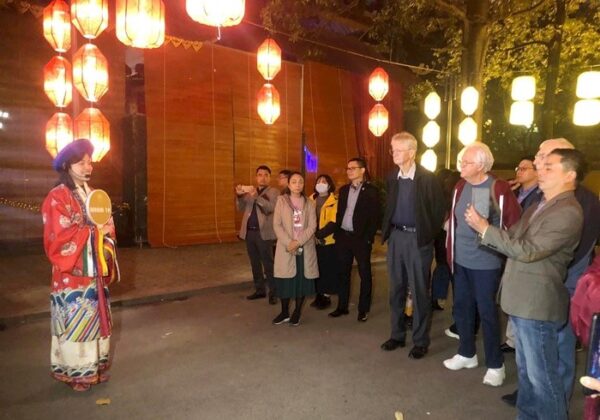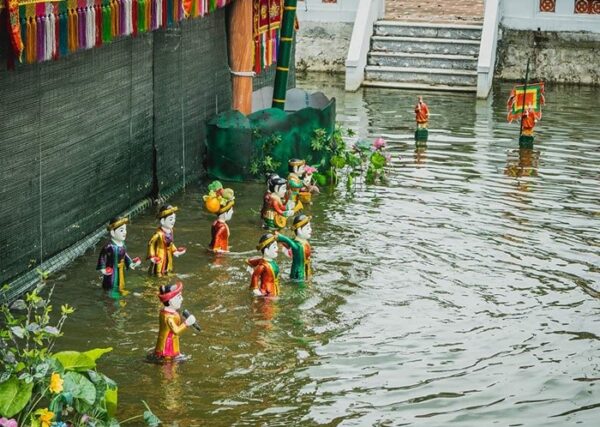Capitalizing on its wealth of historical sites, cultural heritage, and traditional craft villages, Hanoi is strategically focusing on unlocking the value of its heritage to propel the cultural industries forward. Various entities are consistently innovating their approaches, harnessing heritage to progressively convert it into a resource for economic and social development, particularly in the realms of cultural tourism and handicrafts.

Special nighttime tour “Decoding the Thang Long Imperial Citadel” for foreign visitors
Maximizing the Value of Cultural Heritage
In 2022, the Hanoi Party Committee issued Resolution No. 09-NQ/TU regarding the development of the cultural industry in the capital for the period 2021-2025, with a vision extending to 2030 and even 2045. This resolution sets the objective of maximizing the potential, strengths, and cultural values that characterize the millennium-old essence of the capital, transforming these values into developmental resources. Among the 12 sectors of the cultural industry, the city is placing specific emphasis on handicrafts, cultural tourism, architecture, performing arts, and gastronomy. A year after the issuance of Resolution 09, a dynamic and diverse array of activities has unfolded, capitalizing on the value of cultural heritage. Unlike the past, where Hanoi’s historical sites were predominantly “open during the day and closed at night,” many types of heritage and landmarks have come to life through the exploration of cultural industry development. Following the impressive success of a series of nighttime experiential activities, the Management Board of the Hoa Lo Prison Relic recently introduced a new cultural product titled “Sacred Night 3 – Flames of Youth,” honoring the young heroes with real historical stories associated with Hoa Lo Prison. Many scenes have been incorporated into the exploitation to help the public deeply feel and understand the harsh life in the “earthly hell,” the fervent struggle atmosphere of revolutionary predecessors. Scenes such as martyr Nguyen Hoang Ton bravely facing death by guillotine in front of Hoa Lo Prison in 1931, the 1933 hunger strike, the “Turning Prison into a Revolutionary School” movement, and the 1945 prison break journey are vividly depicted. Visitors also have the opportunity to immerse themselves in the role of political prisoners to experience the darkness and stuffiness of the cells and solitary confinement.
In early 2023, the Thang Long – Hanoi Heritage Conservation Center launched a specialized nighttime tour, “Decoding the Thang Long Imperial Citadel,” designed specifically for international visitors. This version introduces several innovations, distinguishing it from the nighttime tour for domestic visitors, “Decoding the Thang Long Imperial Citadel,” unveiled a year ago. The new version brings a fresh, gentle emotional experience while still offering diverse encounters tailored to the preferences of international visitors. The 120-minute nighttime tour has been highly favored by guests.
In addition to the tangible cultural heritage sites, Hanoi boasts a distinctive strength in its intangible cultural heritage activities, particularly in the realm of traditional crafts, with a staggering 1,350 villages of various kinds. Many of these villages have seen infrastructure investments and the implementation of tourism services, embracing digitalization. Notable examples include the Van Phuc Silk Village, the Quat Dong Embroidery Village, and the Ha Thai Lacquerware Village. The renowned Bat Trang Ceramic Village has come to life, leveraging the resources of the Vietnamese Craft Village Essence Center. Tourists are captivated by the seven buildings of the center, inspired by the potter’s wheel and adorned with the earthy red hue of baked clay. The structure serves as an exhibition space showcasing the genealogy, images, and artifacts related to the development of the 19 family lines in Bat Trang. Visitors can explore the essence of Bat Trang’s pottery along with various traditional handicraft villages. The center also offers accommodation, dining, folk art performances, and experiential areas to connect tourists with artisans and ceramic craftsmen.
From the Tet – Lunar New Year until now, almost every day, artisans in Dao Thuc have been welcoming guests. Some days witness up to 2-3 performances. In the past, Dao Thuc’s artisans were concerned about preserving their craft, but now, the younger generation is eager to learn water puppetry, and artisans are enthusiastic about the income generated from performances. Nguyen The Nghi, Head of the Business Department in Dao Thuc Ward, shared that in recent years, the local authorities have been actively supporting the ward in terms of infrastructure and providing assistance in teaching puppetry skills. These efforts have created favorable conditions for the development of tourism in Dao Thuc. Currently, Dao Thuc’s water puppetry not only showcases water puppet performances but also introduces additional cultural village activities, such as taking a traditional boat, learning traditional fishing, experiencing agricultural house construction, and riding buffalo or horse-drawn carriages to admire the rural scenery. Visitors can also choose to explore and experience various historical sites and craft villages in the area.

Dao Thuc Water Puppetry
Many challenges still need addressing
The city has outlined specific solutions to realize the objectives set forth in Resolution No. 09-NQ/TU of the Hanoi Party Committee regarding the development of the cultural industry in the capital. Accordingly, by 2025, the cultural industry is expected to contribute about 5% to the city’s GRDP, and by 2030, it aims to become a spearhead sector, striving to contribute around 8% to the GRDP. The city will continue to invest in preserving old relics and heritage sites, establishing mechanisms to transform industrial heritage, old houses, villas, urban heritage, and memory heritage into new cultural heritage. It also seeks to develop traditional crafts and handicraft products.
However, there are still numerous challenges in leveraging heritage values to “drive the economy.” A UNESCO World Cultural Heritage site like the Thang Long Imperial Citadel only attracts a few hundred thousand tourists each year, which does not align with its potential. Despite having various forms of traditional folk performing arts, only the Thang Long Water Puppet Theater among the city-level theaters operates effectively. In rural areas, locales like the Dao Thuc Water Puppetry are considered rare. Meanwhile, craft villages, which could simultaneously develop various sectors of the cultural industry such as design, cultural tourism, and handicrafts, are producing handcrafted products that often adhere to traditional patterns with minimal improvements and innovations. The number of craft villages attracting tourists remains relatively low.
While cultural heritage resources are readily available, transforming these heritages into attractive products is essential to draw tourists. To achieve this, Hanoi needs a workforce engaged in the cultural industry with higher quality, including training individuals who understand culture and planning long-term programs to produce products with depth, and richness, ensuring promotional objectives, and honoring sustainable heritage. The success of certain tourism products, such as night tours at the Hoa Lo Prison historical site, has proven this. By guiding creative storytelling, these night tours consistently have visitors lining up for their turn to experience the historical narratives.
Concerning the craft village cluster, due to the lack of tourism-savvy artisans, collaboration with travel agencies and specialized support from the craft villages is crucial. Do Trong Doan, representative of the Hanoi Lacquer Village Association, suggests that the city needs to support the establishment of centers or exhibition stores to showcase products within the craft villages. This would facilitate accessibility for businesses and production units, promoting easy exchange and circulation of goods. Regarding design, Ha Thi Vinh, President of the Handicraft and Craft Villages Association in Hanoi, proposes that vocational training institutions develop curricula on product design and specific skills for each product line, encouraging young learners in craft villages to pursue education and enhance local craftsmanship. The urgent task is the digital transformation of these villages, especially in product promotion, to attract tourism.
With the advantages of historical sites, cultural heritage, and craft villages, coupled with the outlined solutions, Hanoi continues to strive to become one of the country’s leading centers for developing cultural industries, positioning itself as the “Creative City.”

